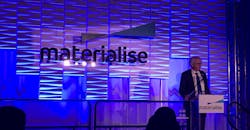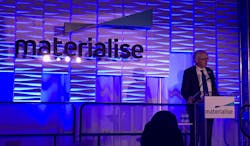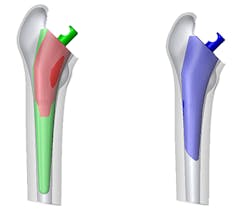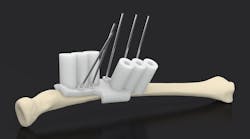In the beginning of June, Materialise opened its doors of its Plymouth, Mich. facility to medical professionals and 3D printers to show how new technology is changing the medical industry. As 3D printing continues to find it ways into more solutions, Materialise and its partners are using the innovative process to curb healthcare costs and improve overall patient health. From software that tracks parts to printing custom models, guides, and implants, technology is changing the operating room (OR).
“With companies from automakers to major hospitals adopting 3D printing, the industry has come a long way since our founder bought his first printer and began writing software for manufacturing nearly 30 years ago,” said Bryan Crutchfield, vice president and general manager of Materialise North America. “With the Materialise Experience, we are bringing together professionals at the forefront of 3D printing technology to show how their organizations are collaborating, innovating, and pushing the boundaries of 3D printing across industries.”
The Materialise Experience will feature speakers and events in three industry tracks:
Additive manufacturing. Leaders from the manufacturing and automotive industries shared their experiences and current innovations in 3D printing and the future of the technology, including metal 3D printing, streamlined production, and applications beyond prototyping. The lineup included Michael Whitens, global director of vehicle & enterprise sciences at Ford Motor Company, who discussed key enablers to accelerate additive manufacturing growth and how to create a mind shift in modelling, part design, and consolidation in materials and supply chain.
Medical devices. Experts from medical device companies discussed how they have utilized 3D printing technology and their vision for future innovations in their companies. During one medical device session, Bill Hartman, director of global technologies at Zimmer Biomet, discussed the value of implementing 3D planning and printing and how the technology enhances patient services.
Hospital. Hospital leaders presented best practices, including how to set up on-site print labs, new approaches to surgeries, insurance reimbursements, and comparisons between insourcing versus outsourcing. Among the hospital leaders presenting Dee Dee Wang, MD, director of the Center for Structural Heart Disease at Henry Ford Health System, discussed the impact of integrating 3D printing and planning into structural heart interventions.
On the first day I toured the Materialise facility, Crutchfield had this to say: “Our open and flexible platforms enable players in industries such as healthcare, automotive, aerospace, art, design, and consumer goods, to build innovative 3D printing applications that make the world a better and healthier place.” The Materialise Innovation Suite is one of the platforms this event introduced to attendees. It is many things, but one of the things that came up multiple times in the tour was how important streamlined documentation was for two-way traceability.
One of the keynotes was Fried Vancraen, CEO o Materialise. He spoke about his passion to make the world a better place with 3D printing. Vancraen was one of the first people to work with 3D printing. He started his adventure in the ’80s and is still helping to change the world today.
Everything from where the raw feedstock came from to where each part went, and what it was used for, is kept in one place. In the medical industry, documentation is important. If a part performs poorly, documentation can provide a fast root cause analysis. For example, if a part fails in testing, documentation can trace the part back to the batch of powder received to make it. But tracing the error back to the powder is only half the answer. With two-way traceability, a search is possible to find all parts associated with that batch. Having all the documentation on a single digital thread makes finding problems, or potential problems possible.
Tracking everything is imperative, as the Materialise facility produces more than400 3D printed components every day, not including all the medical insoles. However, if doctors are only printing medical models, what is the harm of a bad part?
What’s Being Printed?
I am aware of doctors using 3D printers to help plan surgeries. An X-ray, CT scan, or MRI can make a replica organ or area a doctor needs to work on. This can give the doctor better insight and confidence.
Models
Stratasys even released BioMimics 3D, which aims to help students and doctors practice. One issue for students is that there are only so many cadavers, and for doctors, not all bodies are the same. 3D printing can produce as many models as a student feels they need, and a doctor can use prints directly from the patient’s body.
Left: Original design placed in the average bone model, showing overlap between the implant and the cortical bone. Right: Redesigned implant with population analysis.
“The population analysis services that we provide help one facility reduced the number of cadaver specimens needed from 12 to 6—we saved they over $50k in development costs, and generated an additional $100k in sales to the bottom line by getting to the market faster,” says Crutchfield. “Materialise has an Anatomical Data Mining (Adam) service to help with medical imaging-based population design.” Now that everything is digitized, software such as Adam can help medical professionals to:
- Uncover new insights through testing on thousands of virtual patients
- Create representative physical test models
- Reduce the number of design iterations
- Save time by scaling down cadaveric and patient testing
- Support marketing claims through population analysis data
One of the most interesting things, for me, is the ability to create a digital patient. This can replace animal and human testing and streamline FDA approvals with only a simulation base on real-world data. After simulation, a part can be printed and even connected to hydraulics, or whatever is necessary to simulate what is happening in the body.
A research doctor on the tour explained that his work prints out models for this reason. Running fluid thought the model of the body gives him a better idea of fluid flow in areas that might be causing problems. Models can even change its durometer (squishiness) and color to mimic the touch and look of a part with printing technology such as Stratasys’ PolyJet.
One large challenge 3D printing faces is the ability to mimic the feel of cutting the body. The doctor also mentioned that cutting the models and the human body are not the same. But without being able to print fibers to add some resistance into a model being cut, this doesn’t look like it will change anytime soon.
Tooling
For now, the accurate models are reducing time in the OR, but 3D printing offers more than models. Doctors might need to tap or drill into the bone (I’m not a doctor, and the tour guide didn’t get into all the details, but let’s assume to place pins and braces for broken bones). These guides are a large product from 3D medical printing.
The end that contacts the body can be formed to fit exactly to where it needs to be placed, and the hole can be added into the part at the precise angle where it needs to be. These drill guides can speed up surgeries. While this wasn’t mentioned, I would assume if the doctor had a standard bit length, a guide could be printed with the shaft long or short enough so it would also set the depth of the hole.
Some researchers and companies are using Adam for 3D Population Driven Design earlier in the design process. This is giving them an edge in anatomical insight and bringing new designs to the market faster.
From the sound of things, drill guides comprise a large part of the Plymouth facility. I didn’t know there were some many people that needed pins. However, I’m glad there are FDA materials for this process, as I can imagine free-hand drilling into the body sounds much more difficult and time consuming for the doctor.
Implants
I didn’t see a lot of implants on the tour. Perhaps that was in the restricted section of the building. However, as we finished the tour something was said that stuck with me: One of the most important steps of documentation is to make sure the part shows up on time. This sounds so basic, but when making hundreds of parts for multiple hospital with multiple ORs, there is lot riding on getting the right part to the right place on time. Imagine the time, scheduling, and resources need to reserve and prepare an OR. Rescheduling an OR visit could cost a lot of money and time.
The Materialise Experience showed me how many companies are coming together to make healthcare better and more cost-effective, and at the center of all of it is 3D printing. The next couple days were filled with incredible experts and doctors that shared their wisdom and experiences with working with 3D printing.
If you are interested in sharing your experience in the medical field, click here and submit your proposal to speak at MDTX.




